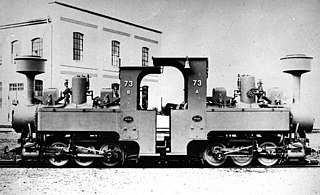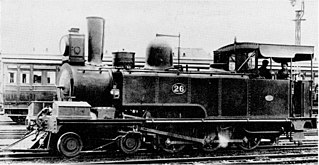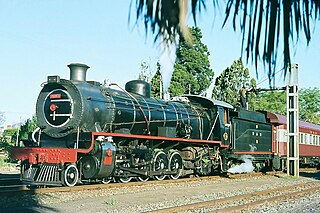Related Research Articles

0-6-0 is the Whyte notation designation for steam locomotives with a wheel arrangement of no leading wheels, six powered and coupled driving wheels on three axles, and no trailing wheels. Historically, this was the most common wheel arrangement used on both tender and tank locomotives in versions with both inside and outside cylinders.

Under the Whyte notation for the classification of steam locomotives, 0-10-0 represents the wheel arrangement of no leading wheels, ten powered and coupled driving wheels on five axles and no trailing wheels. In the United Kingdom, this type is known as a Decapod, a name which is applied to 2-10-0 types in the United States. In the United States, the type is known as ten-coupled.

The South West African Zwillinge 0-6-0T of 1898 was a narrow gauge steam locomotive from the German South West Africa era.

The South African Railways Class 12 4-8-2 of 1912 was a steam locomotive.

The South African Railways Class 8 4-8-0 of 1902 was a steam locomotive from the pre-Union era in the Cape of Good Hope.

The South African Railways Class 8A 4-8-0 of 1902 was a steam locomotive from the pre-Union era in Transvaal.

The South African Railways Class 3 4-8-2 of 1909 was a steam locomotive from the pre-Union era in the Colony of Natal.

The South African Railways Class C 4-6-0T of 1879 was a steam locomotive from the pre-Union era in the Colony of Natal.

The South West African 2-8-0T of 1907 was a steam locomotive from the German South West Africa era.

The South West African 2-8-0 of 1911 was a steam locomotive from the German South West Africa era.

The Natal Government Railways Class K 2-6-0T of 1877 was a South African steam locomotive from the pre-Union era in the Natal Colony.

The South West African Class Ha 0-6-2T of 1904 was a steam locomotive from the German South West Africa era.

The South West African Class Hc 0-6-0T of 1907 was a narrow gauge steam locomotive from the German South West Africa era.

The South West African Jung 0-6-2T of 1904 was a narrow gauge steam locomotive from the German South West Africa era.

The South African Railways NG 0-4-0T of 1899 was a narrow-gauge steam locomotive from the pre-Union era in Transvaal and Natal.

The South African Railways Class 14C 4-8-2 of 1918 was a steam locomotive.

The South African Railways Class 14C 4-8-2 of 1919 was a steam locomotive.

The South African Railways Class 14C 4-8-2 of 1919 was a steam locomotive.

The South West African 0-10-0 of 1911 was a steam locomotive from the German South West Africa era.

The Walvis Bay 2-4-2T Hope of 1899 was a South African steam locomotive from the pre-Union era in the Cape of Good Hope.
References
- 1 2 3 4 Espitalier, T.J.; Day, W.A.J. (1948). The Locomotive in South Africa - A Brief History of Railway Development. Chapter VII - South African Railways (Continued). South African Railways and Harbours Magazine, January 1948. p. 31.
- ↑ Fricke, Klaus; Bude, Roland; Murray, Martin (1978). O&K Steam Locomotives Works List 1892-1945. Verlag Railroadiana, Buschhoven, Germany, ISBN 3-921894-00-X and Arley Hall Publications, Bristol, UK, ISBN 0 9506092 1 8.